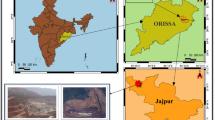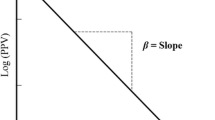Abstract
Ground vibration is one of the major hazards produced by rock-blasting operation. The accurate prediction of vibration is necessary for designing controlled blasting parameters. The existing vibration predictors consider maximum explosive charge weight per delay and distance as the parameters responsible for ground vibration. These predictors are based on the assumption that the geometrical parameters of the blast will be constant for a site. However, the mining sites with bigger production targets have varying geometrical parameters to suit the excavator utility. Accordingly, the other blast design parameters will also have an impact on ground vibration intensity. A principal component analysis is a dimension reduction technique. This technique along with multivariate logarithmic regression has been used in this paper to predict the ground vibration. The technique has classified the blast design parameters into four principal components. The regression with the scores from these principal components has been carried out. The evaluation of the model performance of predictors along with the existing empirical predictors has been carried out using R2 and RMSE values. The evaluation suggests that the predictor with logarithmic regression followed by principal component analysis gives better performance with respect to the existing empirical predictors.







Similar content being viewed by others
References
Agrawal H, Mishra AK (2020) An innovative technique of simplified signature hole analysis for prediction of blast-induced ground vibration of multi-hole/production blast: an empirical analysis. Nat Hazards 100:111–132. https://doi.org/10.1007/s11069-019-03801-2
Ainalis D, Kaufmann O, Tshibangu JP, Verlinden O, Kouroussis G (2017) Modelling the source of blasting for the numerical simulation of blast-induced ground vibrations: a review. Rock Mech Rock Eng 50(1):171–193. https://doi.org/10.1007/s00603-016-1101-2
Ambraseys NR, Hendron AJ (1968) Dynamic behaviour of rock masses. In rock mechanics in engineering practices, Wley
Amiri M, Bakhshandeh Amnieh H, Hasanipanah M, Mohammad Khanli L (2016) A new combination of artificial neural network and K-nearest neighbors models to predict blast-induced ground vibration and air-overpressure. Eng Comp 32(4):631–644. https://doi.org/10.1007/s00366-016-0442-5
Armaghani DJ, Momeni E, Abad SVANK, Khandelwal M (2015) Feasibility of ANFIS model for prediction of ground vibrations resulting from quarry blasting. Environ Earth Sci 74(4):2845–2860. https://doi.org/10.1007/s12665-015-4305-y
Arthur CK, Temeng VA, Ziggah YY (2019) Soft computing-based technique as a predictive tool to estimate blast-induced ground vibration. J Sustain Min 18(4):287–296. https://doi.org/10.1016/j.jsm.2019.10.001
Azimi Y, Khoshrou SH, Osanloo M (2019) Prediction of blast induced ground vibration (BIGV) of quarry mining using hybrid genetic algorithm optimized artificial neural network. Meas J Int Meas Confederation 147:106874. https://doi.org/10.1016/j.measurement.2019.106874
Bakhtavar E, Abdollahisharif J, Ahmadi M (2017) Reduction of the undesirable bench-blasting consequences with emphasis on ground vibration using a developed multi-objective stochastic programming. Int J Min Reclam Environ 31(5):333–345. https://doi.org/10.1080/17480930.2016.1158964
Bayat P, Monjezi M, Rezakhah M, Armaghani DJ (2020) Artificial neural network and firefly algorithm for estimation and minimization of ground vibration induced by blasting in a mine. Nat Resour Res 29(6):4121–4132. https://doi.org/10.1007/s11053-020-09697-1
Dehgani H, Ataee-pour M (2011) Development of a model to predict peak particle velocity in a blasting operation. Int J Rock Mech Min Sci 48(1):51–58. https://doi.org/10.1016/j.ijrmms.2010.08.005
Duvall, W. I., Petkof, B. (1959). Spherical propagation of explosion generated strain pulses in rock. USBM RI 5483
Ghosh, A., Daemen, J. K. (1983). A simple new blast vibration predictor. Proc. 24th US Symp. Rock Mechanics, 151–161
Gorai AK, Himanshu VK, Santi C (2021) Development of ANN-based universal predictor for prediction of blast-induced vibration indicators and its performance comparison with existing empirical models. Min Metall Explor 38:2021–2036. https://doi.org/10.1007/s42461-021-00449-0
Hajihassani M, Jahed Armaghani D, Marto A, Tonnizam Mohamad E (2015) Vibrations au sol prédiction dans quarry dynamitage à travers un réseau neural artificiel optimisé par une concurrence impérialiste algorithme. Bull Eng Geol Env 74(3):873–886. https://doi.org/10.1007/s10064-014-0657-x
Hajihassani M, Jahed Armaghani D, Monjezi M, Mohamad ET, Marto A (2015) Blast-induced air and ground vibration prediction: a particle swarm optimization-based artificial neural network approach. Environ Earth Sci 74(4):2799–2817. https://doi.org/10.1007/s12665-015-4274-1
Harandizadeh H, Armaghani DJ (2021) Prediction of air-overpressure induced by blasting using an ANFIS-PNN model optimized by GA. Appl Soft Comp 99(xxxx), 106904 https://doi.org/10.1016/j.asoc.2020.106904
Hasanipanah M, Monjezi M, Shahnazar A, Jahed Armaghani D, Farazmand A (2015) Feasibility of indirect determination of blast induced ground vibration based on support vector machine. Measurement 75:289–297. https://doi.org/10.1016/j.measurement.2015.07.019
Himanshu VK, Mishra AK, Vishwakarma AK, Roy MP, Singh PK (2022) Explicit dynamics based numerical simulation approach for assessment of impact of relief hole on blast induced deformation pattern in an underground face blast. Geomech Geophys Geo-Energy Geo-Res 8:19. https://doi.org/10.1007/s40948-021-00327-5
Himanshu VK, Mishra AK, Roy MP, Vishwakarma AK, Singh PK (2021) Numerical simulation based approach for assessment of blast induced deformation pattern in slot raise excavation. Int J Rock Mech Min Sci 144:104816. https://doi.org/10.1016/j.ijrmms.2021.104816
Himanshu VK, Roy MP, Mishra AK, Paswan RK, Panda D, Singh PK (2018) Multivariate statistical analysis approach for prediction of blast-induced ground vibration. Arab J Geosci 11(16):460. https://doi.org/10.1007/s12517-018-3796-8
Himanshu, V. K., Roy, M. P. (2017). Prediction of blast induced vibration using numerical simulation. Chapter in Edited book entitled Sustainable Mining Practices (ISBN10 8184876041) 219–227
Holmberg R, P. P. (1978). The Swedish approach to contour blasting. Proceedings of. 4th Annual Conference on Explosives and Blasting Research, International Society of Explosives Engineers, 113–127
Khandelwal M, Kumar DL, Yellishetty M (2011) Application of soft computing to predict blast-induced ground vibration. Eng Comput 27(2):117–125. https://doi.org/10.1007/s00366-009-0157-y
Khandelwal M, Singh TN (2009) Prediction of blast-induced ground vibration using artificial neural network. Int J Rock Mech Min Sci 46(7):1214–1222. https://doi.org/10.1016/j.ijrmms.2009.03.004
Kumar S, Choudhary BS, Mishra AK (2022) Modelling the effects of ground vibrations on the surface due to blasting in underground coal mines. Nat Hazards. https://doi.org/10.1007/s11069-021-04948-7
Kumar S, Mishra AK, Choudhary BS, Sinha RK, Deepak D, Agrawal H (2020) Prediction of ground vibration induced due to single hole blast using explicit dynamics. Min Metall Explor 37:733–741. https://doi.org/10.1007/s42461-019-00162-z
Langefors U, Kihlstrom B (1963) The modern technique of rock blasting. Wiley
Li, X., Huang, J., Luo, Y., Dong, Q., Li, Y., Wan, Y., Liu, T. (2017). Numerical simulation of blast vibration and crack forming effect of rock-anchored beam excavation in deep underground caverns. Shock and Vibration, Volume 2017, Article ID 1812080. https://doi.org/10.1155/2017/1812080.
Mohammadi Azizabadi HR, Mansouri H, Fouché O (2014) Coupling of two methods, waveform superposition and numerical, to model blast vibration effect on slope stability in jointed rock masses. Comput Geotech 61:42–49. https://doi.org/10.1016/j.compgeo.2014.04.008
Mokfi T, Shahnazar A, Bakhshayeshi I, Derakhsh AM, Tabrizi O (2018) Proposing of a new soft computing-based model to predict peak particle velocity induced by blasting. Eng Comput 34(4):881–888. https://doi.org/10.1007/s00366-018-0578-6
Monjezi M, Ahmadi M, Sheikhan M, Bahrami A, Salimi AR (2010) Predicting blast-induced ground vibration using various types of neural networks. Soil Dyn Earthq Eng 30(11):1233–1236. https://doi.org/10.1016/j.soildyn.2010.05.005
Nguyen H, Bui XN (2019) Predicting blast-induced air overpressure: a robust artificial intelligence system based on artificial neural networks and random forest. Nat Resour Res 28(3):893–907. https://doi.org/10.1007/s11053-018-9424-1
Nguyen H, Bui XN (2020) Soft computing models for predicting blast-induced air over-pressure: a novel artificial intelligence approach. Appl Soft Comput J 92:106292. https://doi.org/10.1016/j.asoc.2020.106292
Nguyen H, Drebenstedt C, Bui XN, Bui DT (2020) Prediction of blast-induced ground vibration in an open-pit mine by a novel hybrid model based on clustering and artificial neural network. Nat Resour Res 29(2):691–709. https://doi.org/10.1007/s11053-019-09470-z
Pal Roy P (1991) Vibration control in an opencast mine based on improved blast vibration predictors. Min Sci Technol 12(2):157–165. https://doi.org/10.1016/0167-9031(91)91642-U
Rajabi AM, Vafaee A (2020) Prediction of blast-induced ground vibration using empirical models and artificial neural network (Bakhtiari Dam access tunnel, as a case study). JVC/J Vib Control 26(7–8):520–531. https://doi.org/10.1177/1077546319889844
Rezaeineshat A, Monjezi M, Mehrdanesh A, Khandelwal M. (2020). Optimization of blasting design in open pit limestone mines with the aim of reducing ground vibration using robust techniques. Geomech Geophys Geo-Energy Geo-Res 6(2 https://doi.org/10.1007/s40948-020-00164-y
Roy MP, Mishra AK, Agrawal H, Singh PK (2020) Blast vibration dependence on total explosives weight in open-pit blasting. Arab J Geosci 13(13):531. https://doi.org/10.1007/s12517-020-05560-y
Shida X, Tianxiao C, Jiaqi L, Chenrui Z, Zhiyang C (2021) Blasting vibration control using an improved artificial neural network in the Ashele Copper Mine. Shock and Vibration (2021)https://doi.org/10.1155/2021/9949858
Taheri K, Hasanipanah M, Golzar SB, Majid MZA (2017) A hybrid artificial bee colony algorithm-artificial neural network for forecasting the blast-produced ground vibration. Eng Comput 33(3):689–700. https://doi.org/10.1007/s00366-016-0497-3
Tian E, Zhang J, Soltani Tehrani M, Surendar A, Ibatova AZ (2019) Development of GA-based models for simulating the ground vibration in mine blasting. Eng Comput 35(3):849–855. https://doi.org/10.1007/s00366-018-0635-1
Verma AK, Singh TN (2011) Intelligent systems for ground vibration measurement: a comparative study. Eng Comput 27(3):225–233. https://doi.org/10.1007/s00366-010-0193-7
Zeller RA (2005) Measurement Error, Issues and Solutions (K. B. T.-E. of S. M. Kempf-Leonard (ed.); pp. 665–676) Elsevier https://doi.org/10.1016/B0-12-369398-5/00109-2
Zhang X, Nguyen H, Bui X-N, Tran Q-H, Nguyen D-A, Bui DT, Moayedi H (2020) Novel soft computing model for predicting blast-induced ground vibration in open-pit mines based on particle swarm optimization and XGBoost. Nat Resour Res 29(2):711–721. https://doi.org/10.1007/s11053-019-09492-7
Zhongya Z, Xiaoguang J (2018) prediction of peak velocity of blasting vibration based on artificial neural network optimized by dimensionality reduction of FA-MIV. Math Prob Eng 2018 Article ID 8473547 12 pages 2018 https://doi.org/10.1155/2018/8473547
Zhou J, Li C, Koopialipoor M, Jahed Armaghani D, Thai Pham B (2021) Development of a new methodology for estimating the amount of PPV in surface mines based on prediction and probabilistic models (GEP-MC). Int J Min Reclam Environ 35(1):48–68. https://doi.org/10.1080/17480930.2020.1734151
Acknowledgements
The authors would like to thank the management of M/s Reliance Sasan Power Limited for necessary support during the experimental trials.
Author information
Authors and Affiliations
Corresponding author
Ethics declarations
Conflict of Interest
The authors declare that they have no known competing financial interests or personal relationships that could have appeared to influence the work reported in this paper.
Additional information
Publisher's Note
Springer Nature remains neutral with regard to jurisdictional claims in published maps and institutional affiliations.
Highlights
•PCA is a useful data classification technique and can be used for ground vibration prediction.
•PCA with logarithmic regression gives a more accurate prediction than existing empirical predictors.
•The principal component comprising MCPD, distance, and column length of explosive charge has maximum influence on PPV.
Supplementary Information
Below is the link to the electronic supplementary material.
Rights and permissions
Springer Nature or its licensor holds exclusive rights to this article under a publishing agreement with the author(s) or other rightsholder(s); author self-archiving of the accepted manuscript version of this article is solely governed by the terms of such publishing agreement and applicable law.
About this article
Cite this article
Himanshu, V.K., Mishra, A.K., Vishwakarma, A.K. et al. Prediction of Blast-Induced Ground Vibration Using Principal Component Analysis–Based Classification and Logarithmic Regression Technique. Mining, Metallurgy & Exploration 39, 2065–2074 (2022). https://doi.org/10.1007/s42461-022-00659-0
Received:
Accepted:
Published:
Issue Date:
DOI: https://doi.org/10.1007/s42461-022-00659-0




